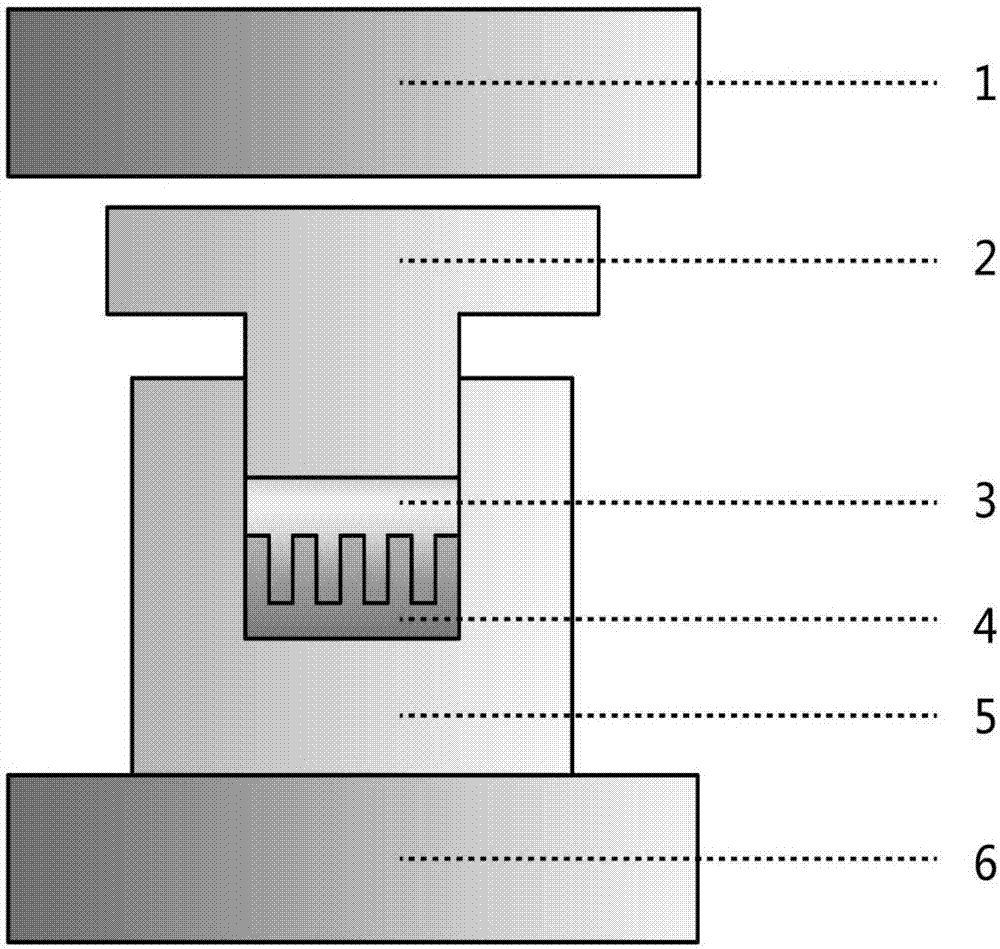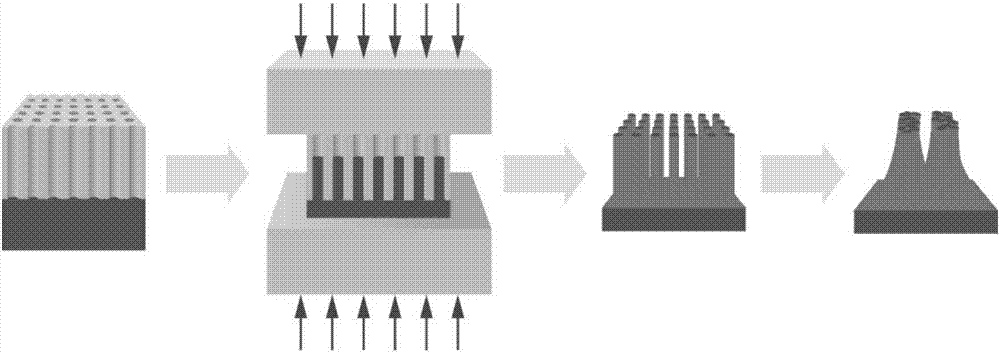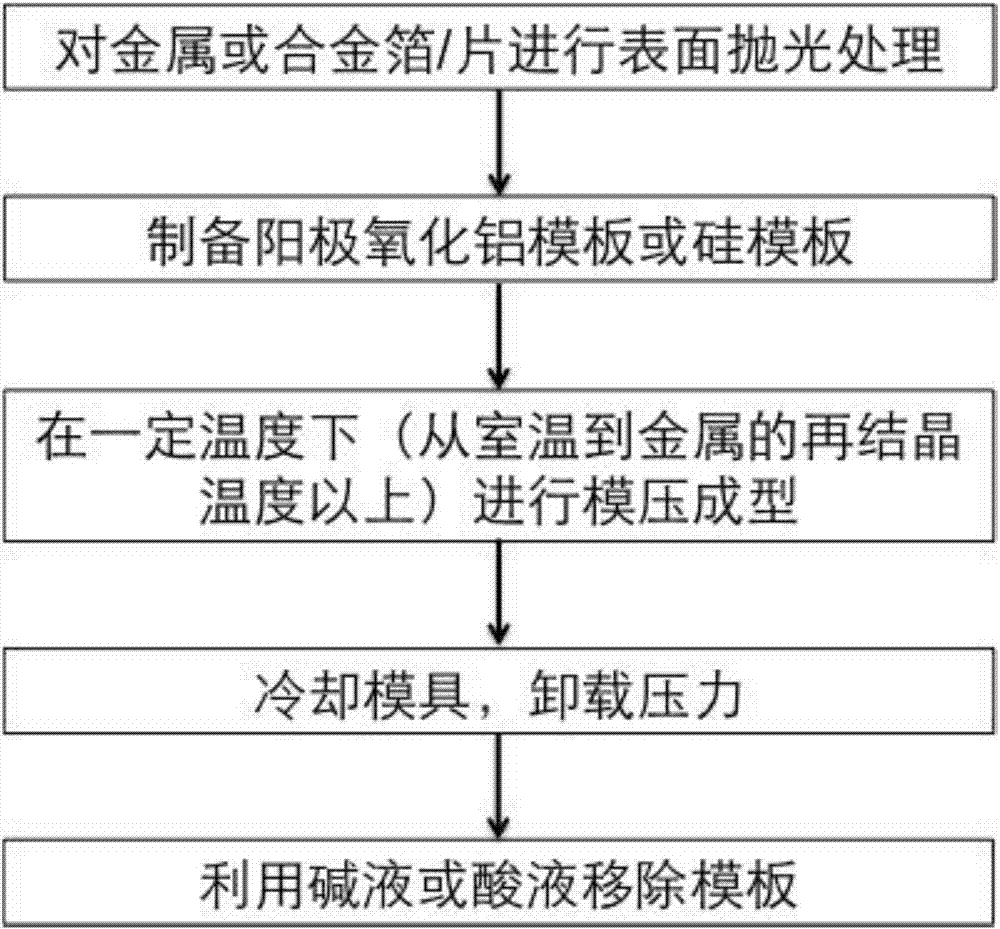Preparing method for metal and alloy micro-nano structure or nanowire array of metal
A technology of micro-nano structure and nanowire array, which is applied in the field of material science and engineering, can solve the problems of chemical pollution, environmental pollution, and low production efficiency, and achieve the effect of complex solution, simple and convenient operation, and high production efficiency
- Summary
- Abstract
- Description
- Claims
- Application Information
AI Technical Summary
Problems solved by technology
Method used
Image
Examples
Embodiment 1
[0048] Preparation of gold nanowire arrays with different diameters (30-200nm) by thermocompression molding:
[0049] Cut the gold foil into the required size of 10mm*10mm, mechanically polish the 10mm*10mm foil, and then repeatedly ultrasonically clean it in acetone, ethanol, and deionized water, take it out and dry it before use.
[0050] A double-pass porous anodized alumina template is prepared by a secondary oxidation method, and the template holes of the alumina template are evenly distributed, and the hole diameter is 30-200nm, and the hole depth is a porous ordered array of 70 μm.
[0051] Place the lower steel mold 5 above the lower pressure head 6 of the hydraulic press, place the double-pass porous anodized aluminum template 4 in the lower steel mold 5, and then place the gold foil 3 with a size of 10mm*10mm directly above the template 4, and the gold foil 3 The polished side fits closely with the template 4, and the upper steel mold 2 is covered. Turn on the tempe...
Embodiment 2
[0054] Fabrication of gold nanowire arrays with a diameter of 50 nm and a length of up to 20 μm by thermocompression molding:
[0055] Cut the gold foil into the required size of 10mm*10mm, mechanically polish the foil, and then ultrasonically clean it repeatedly in acetone, ethanol, and deionized water respectively, take it out and dry it before use.
[0056] A porous anodized alumina template is prepared by a secondary oxidation method, and the template pores of the alumina template are evenly distributed, and a porous ordered array with a diameter of 50 nm and a depth of 70 μm is used.
[0057] Place the lower steel mold 5 above the lower pressure head 6 of the hydraulic press, place the double-pass porous anodized aluminum template 4 in the lower steel mold 5, and then place the gold foil 3 with a size of 10mm*10mm directly above the template 4, and the gold foil 3 The polished side fits closely with the template 4, and the upper steel mold 2 is covered. Turn on the tempe...
Embodiment 3
[0060] Preparation of silver nanowire arrays with different diameters (30nm-200nm) by thermal compression molding:
[0061] Cut the silver foil into the desired size of 10mm*10mm, mechanically polish the foil, and then ultrasonically clean it repeatedly in acetone, ethanol, and deionized water respectively, take it out and dry it before use.
[0062] A double-pass porous anodized alumina template is prepared by a secondary oxidation method, and the template holes of the alumina template are evenly distributed, and a porous ordered array with a diameter of 30nm-200nm and a hole depth of 70 μm.
[0063] Place the lower steel mold 5 above the lower pressure head 6 of the hydraulic press, place the double-pass porous anodized aluminum template 4 in the lower steel mold 5, and then place the silver foil 3 with a size of 10mm*10mm directly above the template 4, and the silver foil The polished side of the foil 3 is closely attached to the template 4, and the upper steel mold 2 is co...
PUM
| Property | Measurement | Unit |
|---|---|---|
| size | aaaaa | aaaaa |
| length | aaaaa | aaaaa |
| thickness | aaaaa | aaaaa |
Abstract
Description
Claims
Application Information
 Login to View More
Login to View More - R&D
- Intellectual Property
- Life Sciences
- Materials
- Tech Scout
- Unparalleled Data Quality
- Higher Quality Content
- 60% Fewer Hallucinations
Browse by: Latest US Patents, China's latest patents, Technical Efficacy Thesaurus, Application Domain, Technology Topic, Popular Technical Reports.
© 2025 PatSnap. All rights reserved.Legal|Privacy policy|Modern Slavery Act Transparency Statement|Sitemap|About US| Contact US: help@patsnap.com



